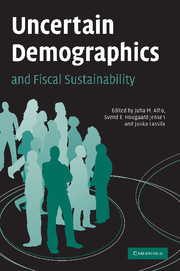Book contents
- Frontmatter
- Contents
- List of figures
- List of tables
- List of contributors
- Preface
- 1 Introduction
- Part I Uncertain demographics
- Part II Measuring sustainability in a stochastic environment
- 4 Fiscal implications of demographic uncertainty: comparisons across the European Union
- 5 Demographic uncertainty and pension projections
- 6 Demographic uncertainty and health care expenditure
- Comment: Assessing the uncertainty in long-term fiscal projections
- Part III Enhancing sustainability
- Part IV Extensions
- Index
- References
4 - Fiscal implications of demographic uncertainty: comparisons across the European Union
Published online by Cambridge University Press: 22 September 2009
- Frontmatter
- Contents
- List of figures
- List of tables
- List of contributors
- Preface
- 1 Introduction
- Part I Uncertain demographics
- Part II Measuring sustainability in a stochastic environment
- 4 Fiscal implications of demographic uncertainty: comparisons across the European Union
- 5 Demographic uncertainty and pension projections
- 6 Demographic uncertainty and health care expenditure
- Comment: Assessing the uncertainty in long-term fiscal projections
- Part III Enhancing sustainability
- Part IV Extensions
- Index
- References
Summary
Introduction
It is now well understood that many countries may face considerable budgetary problems as a result of demographic change and population ageing. A number of different countries have a range of economic models intended for making long-term projections and these are traditionally used to assess the budgetary impact of population change. The best summary statistic of budgetary imbalance is provided by an estimate of the immediate permanent change in taxation needed to deliver fiscal solvency. The justification for addressing the problem in this way is twofold. First of all, it corresponds to a rough notion of intergenerational equity: each generation faces the same tax burden. Second, there are now well-established arguments that fiscal policy is optimal when expected future taxes are constant (Flemming, 1987). This statistic can be calculated from a range of different types of model. It has to be remembered, however, that it is a summary statistic for the purpose of comparing different projections; in models where people's behaviour is sensitive to tax rates and which have been simulated on the assumption that taxes are varied period by period (e.g. to maintain short-term fiscal balance) the projections will be slightly different from those which would result if this constant tax increase were actually imposed.
There is, nevertheless, considerable uncertainty surrounding such projections. Two distinct sources of uncertainty can be identified. One is uncertainty in the parameters of the model used to project revenues and expenditures.
- Type
- Chapter
- Information
- Uncertain Demographics and Fiscal Sustainability , pp. 65 - 81Publisher: Cambridge University PressPrint publication year: 2008



